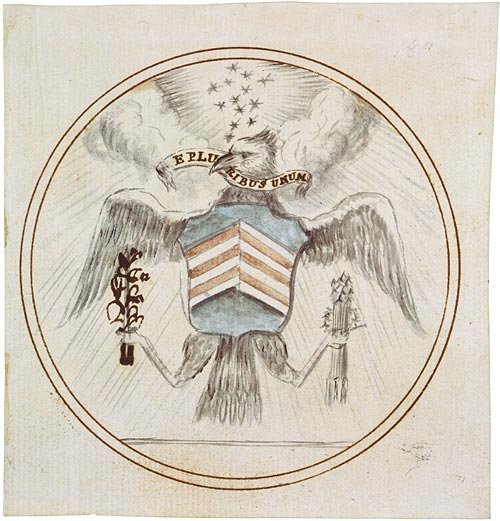Flag facts: history, codes, design, and symbolism.
Photo: A poignant reminder that our aspirational quest for “a more perfect Union” is far from over and continues to this day. “Mrs. Yoshiye Abe, an American of Japanese ancestry, helps to make American flags in a Denver factory. Photograph shows former incarceree working at a flag factory after being released from the concentration camp where she was incarcerated during World War II. United States Office of War Information. Published between 1942 and 1945.” Credit: U.S Library of Congress
What is the origin of the U.S. flag?
The Declaration of Independence was adopted on July 4, 1776, but it was not until June 14, 1777 that the Continental Congress officially stipulated (with the first Flag Act) that the national flag would have thirteen alternating red and white stripes along with an emblem of thirteen white stars on a blue field.
Prior to 1777, the colonies and the Continental Army used various flags, including the Grand Union Flag, which featured 13 red and white stripes paired with the British Union Jack in the upper corner. This flag was used by George Washington’s army and served as a prominent symbol of the colonies during the early stages of the Revolution. Although often considered the precursor to the modern American flag, it lacked stars.
What are the core design elements of the American flag?
The American flag’s design is characterized by two key features: 13 horizontal stripes alternating red and white, and a blue rectangular emblem adorned with white stars. The stripes symbolize the 13 original colonies that gained independence from Britain during the American Revolutionary War. The blue emblem located on the hoist side at the top left corner features 50 white stars representing the states of the Union. Historically, an emblem placed in this location is known as a “canton” and serves to symbolize a nation's or region's identity, history, or relationship to another entity.
The Continental Congress’s 1977 Flag Resolution established the first congressional description of the flag. However, the Act did not precisely define the order of the stripe’s colors nor the shape or arrangement of the stars. While numerous theories, legends, and stories exist about the origins of the first U.S. flag design, there is no scholarly consensus regarding who might have been the designer.
What is the Flag Code?
The United States Flag Code outlines guidelines for displaying the flag appropriately, such as ensuring it is illuminated if flying at night. It also emphasizes the importance of treating it with care, avoiding contact with the ground, and refraining from using it as clothing. While many of these guidelines are advisory, the First Amendment plays a crucial role in this context. It protects the right to free speech, which courts have ruled includes the expression of dissenting views about the flag. Here is the full text of the code (as of May 14, 2025).
Illustration: Charles Thomson, designer of for the Great Seal of the United States, is credited with interpreting the meaning of the flag’s colors. Source: Records of the Continental and Confederation Congresses and the Constitutional Convention, 1774-1789; National Archives.
What is the symbolic meaning of the flag’s colors - red, white, and blue?
To many, the colors of the American flag hold deep symbolic meaning and represent the nation’s values and heritage. At the time of the adoption of the flag in 1777, the colors red, white, and blue held no official significance. However, in 1782, Charles Thomson, Secretary of the Continental Congress and co-designer of The Great Seal of the United States offered an interpretation when he linked the colors in the Seal to those used in the United States flag.
He explained the meaning as follows:
In the seal’s pales (the vertical stripes in the shield) “white represented purity and innocence, red signified hardiness and valor, and blue represented the color of the Chief , symbolizing vigilance, perseverance, and justice.” (The Chief is the broad horizontal band above the stripes in the shield.
Thomson’s interpretation is widely accepted to this day.
Photo: The Star-Spangled Banner. This iconic flag once measured 30 by 42 feet and weighed about 50 pounds. Over the years, fabric along the flag’s fly end was lost both as a result of cuttings once given away as tokens and also due to aging. Citation: NMAH c. 1964, Author/Creator: Unknown, Smithsonian Institution Archives.
What is the “Star Spangled Banner”?
The Star-Spangled Banner holds significant importance as the garrison flag that flew over Fort McHenry on September 14, 1814, during the war of 1812. Inspired by witnessing the banner aloft as the Battle of Baltimore abated, Francis Scott Key composed the poem “Defense of Fort M’Henry.” Scott’s words were later set to the popular song “To Anacreon in Heaven” by Jon Stafford Smith. In 1931, the song became the national anthem of the United States.
Today, this historic flag is permanently housed at the Smithsonian’s National Museum of American History. It is the only official American flag to have 15 stripes.
How has the flag changed over time?
Throughout history, the American flag has undergone changes. In 1795, the number of stripes was briefly increased to 15. However, most alterations have been related to the number and arrangement of the stars on the blue field. The current flag design, which features 50 stars, was adopted in 1960 after Alaska and Hawaii gained statehood.


